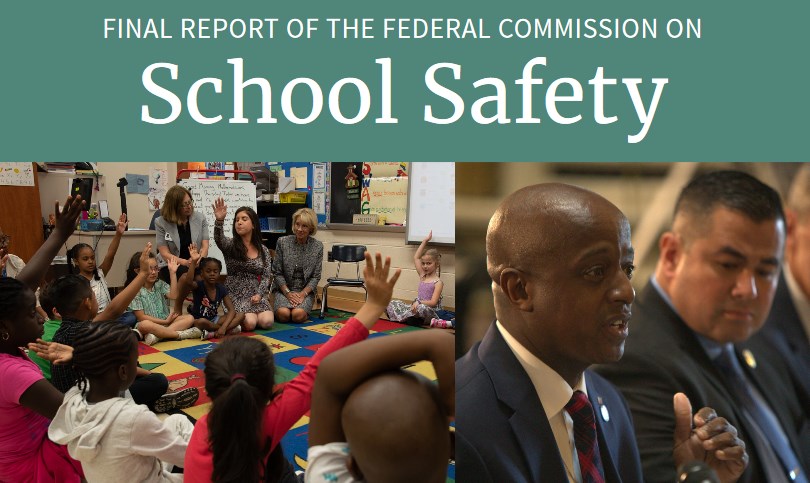US government's School Safety report calls on ESRB to 'review and improve' its policies
The report was commissioned in the wake of the Stoneman Douglas mass murder.

The final report of the Federal Commission on School Safety, struck earlier this year following the horrific mass murder at Marjory Stoneman Douglas High School, acknowledges that the ESRB rating system has a "high level of trust among parents," but nonetheless recommends that it and other media rating agencies "review and improve policies to ensure access to content is limited to age-appropriate consumers."
The report is broken down into three general areas: Preventing violence in schools, protecting from and mitigating its damage, and responding to and recovering from its effects. Specific topics range from "character development" and cyberbullying to the effectiveness of "extreme risk protection orders" [ERPO], having more military veterans and retired police working as teachers, the impact of press coverage on mass shootings, and, of course, "violent entertainment and rating systems."
"Children have 24/7 access to multiple forms of entertainment at their fingertips. Their exposure to violent entertainment is of particular concern—in television, videogames, social media, music, movies, graphic novels, and books. Violent content is ubiquitous across these platforms and continues to grow," the chapter on "Violent Entertainment and Rating Systems" begins.
"Neighbors of the alleged Parkland shooter, for instance, told reporters that he often played violent videogames for up to 15 hours a day. According to one, 'It was kill, kill, blow up something, and kill some more, all day'."
At meeting on school safety, President Trump says violence in video games and movies is responsible for shaping young people’s thoughts: “We have to do something about maybe what they’re seeing” https://t.co/VfXvVkwQmq pic.twitter.com/vbt2t0dhtmFebruary 22, 2018
The report estimates that violence is depicted in 90 percent of movies, 68 percent of videogames, 60 percent of television shows, and 15 percent of music videos, and states that "some scholars argue that children who regularly consume violent images are more prone to social isolation and aggressive behavior." But it also notes that other studies have found the opposite effect, and that "their authors contend that most studies in this area find only weak correlational results and not causal results of the potentially negative effects of violent entertainment."
Some criticism is directed toward the Motion Picture Association of America's rating system for being too simplistic and uninformative, and for overuse of the PG-13 rating, which nobody really understands, while television and music industry rating systems get little more than a nod for existing. The ESRB is the one that's centered out, which may not be surprising—but it's largely positive, which kind of is.
"As the videogame industry’s self-regulatory body, the ESRB is responsible for enforcing its rating system. It requires complete disclosure of content during the rating process and proper display of rating information on packaging and wherever the game is marketed or sold. This is to comply with industry-adopted advertising and marketing guidelines intended to ensure that video games are not marketed to audiences for whom they are not intended," the report says.
The biggest gaming news, reviews and hardware deals
Keep up to date with the most important stories and the best deals, as picked by the PC Gamer team.
"According to a 2016 survey, 86 percent of parents with children who play video games know about the ESRB’s rating system, and 73 percent say they check a computer or videogame’s rating before buying it for their children. The ESRB rating system has gained high levels of trust among parents, who regularly report being satisfied with the level of information as they choose which games to select for children."
A violent videogame montage shown at the White House in March.
The report urges parents to be aware of, and discuss, the media their children are consuming, and to take advantage of external sources of information to learn more about it. Naturally, improvements are recommended, but it's so vague as to be almost entirely meaninglessness: "While some self-regulators provide easy-to-understand rating systems and effectively restrict content through retailer requirements, all of them should review and improve policies to ensure access to content is limited to age-appropriate consumers."
Interestingly, the report notes that the Obama administration called for $10 million in funding for the CDC "to conduct further research on the relationship between videogames, media images, and violence" following the Sandy Hook mass murder, but makes no mention of the fact that Congress has repeatedly rejected efforts to fund or promote research into gun violence. It also concludes that minimum age requirements for firearms purchases "is unlikely to be an effective method for preventing or reducing school shootings," and while it encourages states to adopt ERPO laws, it cautions against making them overly broad and says that they should ensure the "prompt return of firearms at the conclusion of the order’s duration."
Thanks, Variety.

Andy has been gaming on PCs from the very beginning, starting as a youngster with text adventures and primitive action games on a cassette-based TRS80. From there he graduated to the glory days of Sierra Online adventures and Microprose sims, ran a local BBS, learned how to build PCs, and developed a longstanding love of RPGs, immersive sims, and shooters. He began writing videogame news in 2007 for The Escapist and somehow managed to avoid getting fired until 2014, when he joined the storied ranks of PC Gamer. He covers all aspects of the industry, from new game announcements and patch notes to legal disputes, Twitch beefs, esports, and Henry Cavill. Lots of Henry Cavill.


